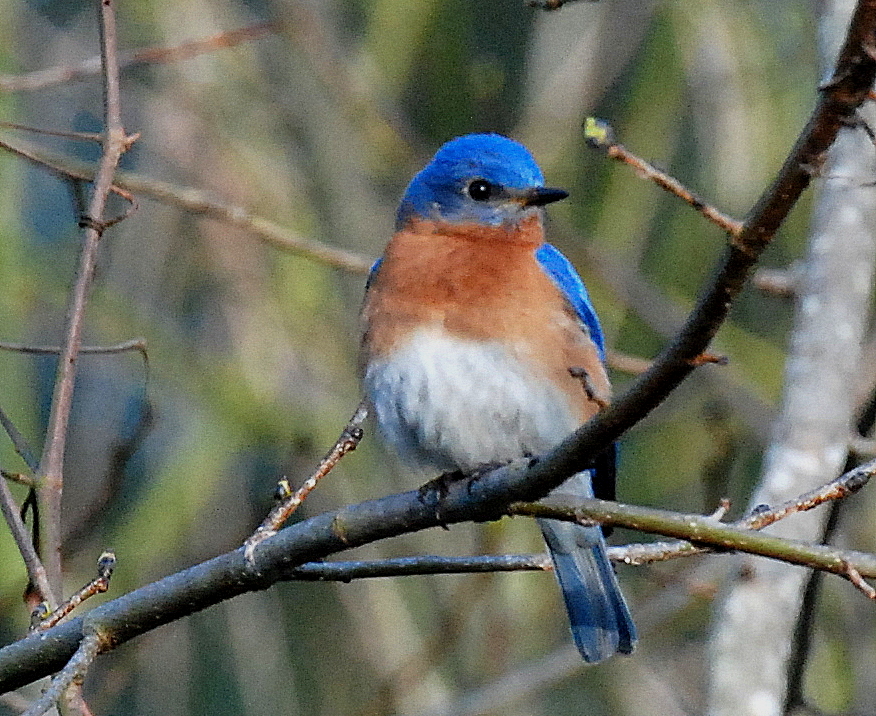
Eastern bluebird (Terry W. Johnson)
By Terry W. Johnson
When the first European colonists set foot in North America, the eastern bluebird was nesting almost exclusively in cavities found in native trees. However, as the population of these early settlers swelled and began to dramatically change the environment, bluebirds began nesting in places that were previously unavailable to them. Some of these sites continue to be truly odd.
One of the earliest reports of bluebirds nesting in strange places appeared in a newspaper column published in the 1800s. The column reported that a pair of bluebirds nested in a railroad signal ball. Despite the ball being raised and lowered scores of times every day, the birds successfully raised two broods of young.
It seemed that each time the ball was raised and lowered, if an adult was in the nest, it would simply fly to a nearby fence and wait for the signal to return to its original position. At such time, without hesitation, it would fly back to its nest.
In another case, bluebirds attempted to nest in what was described as a stone jar lying on its side in a cemetery. For some unexplained reason, a female bluebird built a nest and laid four eggs in the jar. All went well until a well-intentioned visitor noticed the jar lying on its side and set it upright. This resulted in one egg being broken and the nest being abandoned.
There are any number of reports of bluebirds nesting in mailboxes and newspaper delivery tubes. Bluebirds have also been known to nest in jars, cans, clothespin bags and even a pair of shoes left to dry atop a car.
In Texas, a pair of bluebirds nested alongside a busy highway in a hole in the pole supporting a traffic sign. That in itself is different; however, what makes this report truly odd is that the hole was only 24 inches above the ground.
From time to time, bluebirds will nest in vehicles. Nests have been found in car grills and bumpers, and even the tailpipes of scrapped cars. In one instance, a pair of bluebirds nested, in of all places, the gas tank of a retired tractor.
Several years ago, Dr. Jerry Payne, a retired U.S. Department of Agriculture research scientist and a Georgia DNR Wildlife Resources Division volunteer, showed me yet another bizarre bluebird-nest site.
Over the years, Jerry (recently decreased) and his wife Rose did more to enhance their property for wildlife than any other couple I know. Their accomplishments include erecting literally scores of bird nesting structures. Because of their efforts, countless young bluebirds and other cavity-nesting birds fledged from the Paynes’ boxes.
In addition to his conservation endeavors, Jerry created what is probably the largest bottle tree forest in the entire state. I call it a bottle tree forest because it contains more than 140 bottle trees.
Jerry dedicated one of these trees to the eastern bluebird. This tree is bedecked with scores of colorful bottles. What makes it even more unique is that near the top, a bluebird nesting box is nestled among the colorful bottles.
When I first looked at the tree, I was taken aback by the tree's dazzling kaleidoscope of colors. Then when I gazed at the box, I could not help but wonder if a bluebird would actually nest in such a unique but unnatural setting. When I asked Jerry about it, he said bluebirds had successfully nested there for years.
After seeing a bluebird box surrounded by colorful bottles, I now wonder if I will ever see anything stranger than bluebirds nesting in a bottle tree.
Terry W. Johnson is a retired Nongame program manager with the Wildlife Resources Division and executive director of The Environmental Resources Network, or TERN, friends group of the division’s Nongame Conservation Section. (Permission is required to reprint this column.) Learn more about TERN, see previous “Out My Backdoor” columns, read Terry’s Backyard Wildlife Connection blog and check out his latest book, “A Journey of Discovery: Monroe County Outdoors.”




















